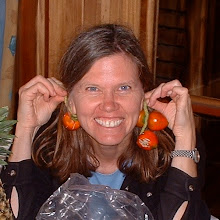Some Tico friends just took us on a two day odyssey to the dry tropical forest on the Nicoya Peninsula. The cabin near Paquera where we stayed belongs to friends of our friends and is rustic in the extreme. The rooms are on the second floor and if anyone rolls over in bed, the entire structure shakes. We love going there not for sumptuous accommodations but because the cabins are deep in the forest near a river and we are the only people there when we stay. At dawn we awoke to Mantled Howler Monkeys roaring from the trees near the cabin. It's a wonderful wild sound. Some people find it scary, but one should keep in mind that they are vegetarians. During the day, Mr. Rududu took this portrait.
On the ground level of the cabin is a cooking area. The essential piece of equipment for a trip like this is the electric rice cooker. Unfortunately the cord was forgotten at home, but with typical can-do spirit, Juan found a live wire up in the rafters and wired the cooker directly into the cabin.
You can see some of the drinking straw left after he cut pieces of it to use as little insulators where the wires were connected. The beans were cooked over a wood fire, a method that Ticos believe makes them much tastier.
In the morning, we went for a long walk along the river. We must have crossed the river about two dozen times and Michael, the local friend who guided us there, kindly built a lot of bridges of stepping stones and helped us gringos across so we wouldn't get our feet wet.
We saw many interesting birds and this Kinkajou. It's a member of the raccoon family and difficult to see as it's mostly nocturnal.
After the hike, we went for a dip in the swimming pool filled with fresh river water that pours in so fast that there is a complete water change every hour or so. It's very hot there and it's wonderful to swim in such clean, chemical-free water.
On the way home, we made a stop to get mangoes from a friend's tree. Our friends have a big family and lots of friends to share mangoes with. We're lucky to be among them.
On the ground level of the cabin is a cooking area. The essential piece of equipment for a trip like this is the electric rice cooker. Unfortunately the cord was forgotten at home, but with typical can-do spirit, Juan found a live wire up in the rafters and wired the cooker directly into the cabin.
You can see some of the drinking straw left after he cut pieces of it to use as little insulators where the wires were connected. The beans were cooked over a wood fire, a method that Ticos believe makes them much tastier.
In the morning, we went for a long walk along the river. We must have crossed the river about two dozen times and Michael, the local friend who guided us there, kindly built a lot of bridges of stepping stones and helped us gringos across so we wouldn't get our feet wet.
We saw many interesting birds and this Kinkajou. It's a member of the raccoon family and difficult to see as it's mostly nocturnal.
After the hike, we went for a dip in the swimming pool filled with fresh river water that pours in so fast that there is a complete water change every hour or so. It's very hot there and it's wonderful to swim in such clean, chemical-free water.
On the way home, we made a stop to get mangoes from a friend's tree. Our friends have a big family and lots of friends to share mangoes with. We're lucky to be among them.




































